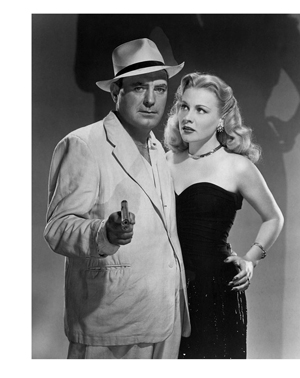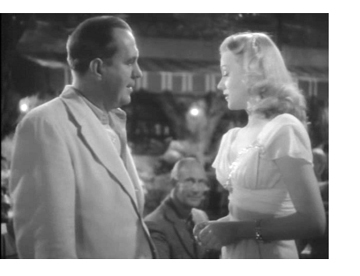
 |
|
|
|
Riffraff is a 'small' film noir discovery with big-film qualities. Cinematographer Ted Tetzlaff had ambitions to direct, and after a false start a few years earlier, got his chance at RKO in the late 1940s. I'm a fan of Mr. Tetzlaff's The White Tower, which was partly shot in Europe, in color. That Howard Hughes would let him do that, is pretty interesting. Tetzlaff's most popular picture is 1949's The Window, a suspense noir taken from a Cornell Woolrich story. The Window had the more typical fate of being held up by Hughes. It was made right after Riffraff, yet wasn't released until 1949. On the surface Riffraff 1 is a 'foreign intrigue-er' South of the border, with Yanks trading double-crosses with shifty international types. It's a beautiful in-studio production that can boast a snappy smart-talk screenplay, actors that seem to be enjoying themselves, and a director that knows how to express mood and excitement with his camera. 
The opening sequence is a tour-de-force (read: good sequence) without dialogue. On a plane between Peru and Panama, one of two passengers, a nervous man, jumps to his death halfway through the flight. At least, that's the story told by the other passenger, Charles Hasso (Marc Krah) - who is now carrying the suicide's briefcase. In Panama Hasso hotfoots it to the door of laid-back private detective Dan Hammer (Pat O'Brien), asking for his services as a bodyguard. Hammer is also contacted by the worried oilman Walter Gredson (Jerome Cowan), who tells him that his messenger carrying an important oil field map has died on a plane from Peru. The map is missing. Hammer runs up the price for recovering the map, only to find that Hasso has been murdered. Two other individuals soon attach themselves to the dangerous search for the map. Untrustworthy Eric Molinar (Walter Slezak) wants the map and is willing to threaten Hammer to get it. Gorgeous Maxine Manning (Anne Jeffreys) rejects Dan's requests for help, but then becomes attached to him. Dan doesn't realize that Gredson is playing all of these people at the same time, hoping that one of them will locate the missing map. The only thing that keeps Hammer from getting in too deep is that the local policeman Dominguez (Jason Robards Sr.) knows that he's an honest guy. When more people turn up dead, Dominguez still trusts Hammer. Riffraff grabs us right away with the sequence that Alfred Hitchcock would surely admire. The moving camera establishes the situation (rain, lonely airfield, unsavory passengers) and sets up the tension without one expository sentence. When the co-pilot and the remaining passenger Hasso are standing next to the airplane's open door (who's going to pay for the lost door?), it's clear to us that Hasso is definitely not a good guy. Things get much lighter in Panama. O'Brien's lazy, smart-talking private dick, has a habit of negotiating harder so that he can work less. Hammer thinks he's pretty cute when he claims that he'll find Hasso in a couple of days, when Hasso is already his client. Gredson is just a worrywart, but Slezak's Molinar is a slick customer who insinuates all kinds of malice behind his words. We immediately assume that he killed Hasso. 
The characterizations are standard, but the actors flesh them out well. I'm not a Pat O'Brien fan, well, at least not beyond 1934 or so. O'Brien wears this hat that looks like a Panama except that it's made of fuzzy felt. After one day it would be completely stained with sweat, and is therefore the last thing you'd want to wear in a tropical country. O'Brien and Anne Jeffreys have good verbal byplay, even though they don't completely click, chemistry-wise. He's over-aged and she's far too cool for him. The nature of the dialogue and their general relationship -- "You're my kind of girl but romance is for saps" -- is just fine. Actually, everything about Riffraff makes us feel that it was written for Robert Mitchum -- Pat O'Brien isn't a hipster, but he puts on a Mitchum-friendly, "I don't care" attitude. Hammer's relationship with Maxine Manning suggests that the script could have been written for Humphrey Bogart and Lauren Bacall. Pat and Maxine meet cute, trade slightly suggestive dialogue, etc. At several moments Anne Jeffreys almost seems to be imitating Lauren Bacall, entering and exiting rooms with lines that sound like veiled come-ons. Jeffreys is just fine, one of many bright faced, intelligent actresses that didn't reach star status in the post-war starlet stampede. Maybe it wasn't smart for her to 'do' Bacall, but it makes the movie more amusing. Jeffreys' career didn't skyrocket, but everybody saw her a few years later opposite Leo G. Carroll in a TV series of Topper. And she's still working, in her 90s! Hammer has a loyal cabbie, 'Pop' (Percy Kilbride) who is just as laconic and laid back as he is. His car is an ancient wreck that barely starts; Tetzlaff enjoys shots that begin on the tailpipe, as we wait for the first ignition backfire. Instead of being comic relief, Pops inserts himself into the drama from time to time. The only obvious comic ang'e is Hammer's dog, which is even lazier than he is, blocking doorways, etc. I guess the filmmakers were plundering the greats, and became inspired by Asta from The Thin Man. |
|||||||||||||||||||
Review Staff | About DVD Talk | Newsletter Subscribe | Join DVD Talk Forum
Copyright © MH Sub I, LLC dba Internet Brands. | Privacy Policy
Subscribe to DVDTalk's Newsletters
|